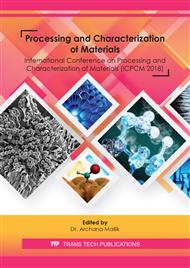p.84
p.91
p.97
p.106
p.114
p.121
p.133
p.140
p.145
Thermal Modeling of Transport Phenomena for a Pulsed Laser Melting Process
Abstract:
Single pulsed laser melting in a cylindrical titanium alloy work piece is studied numerically using an axisymmetric model. Finite volume method and Tri-Diagonal Matrix Algorithm (TDMA) are used for discretization of the energy equation and solving the resulting algebraic equation respectively in order to obtain temperature distribution inside the computational domain. Heat losses from the irradiated surface takes place through convection and radiation and other surfaces are kept insulated. A volumetric and Gaussian laser is irradiated on the work piece. Validation of the present model with the existing literature is done first and the results agree very well. Then, the detailed transport phenomena during the laser melting process is studied using the model. The enthalpy porosity technique is used track the melt pool shape and size. The role of natural convection and Marangoni convection in controlling the shape of melt pool is discussed. Maximum temperature results at domain centre and it then decreases exponentially along the axial and radial direction of the work piece because of Gaussian nature of the pulse. The numerical results obtained can provide the direction to develop models for all type of laser applications used in the industry.
Info:
Periodical:
Pages:
114-120
Citation:
Online since:
February 2020
Authors:
Keywords:
Price:
Сopyright:
© 2020 Trans Tech Publications Ltd. All Rights Reserved
Share:
Citation:


